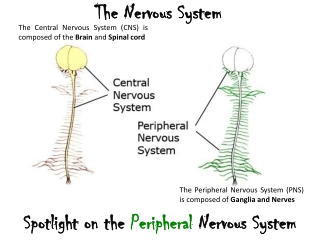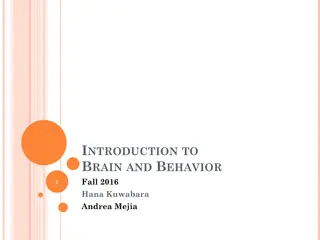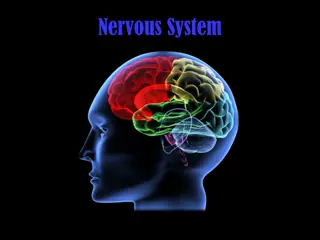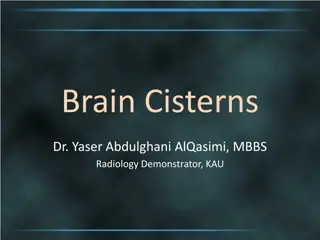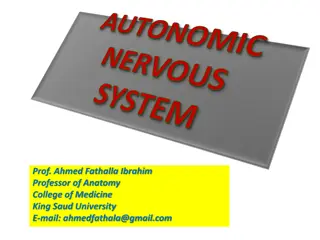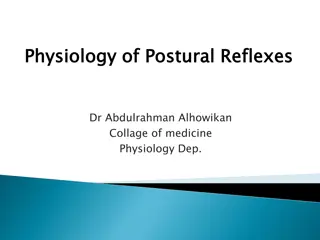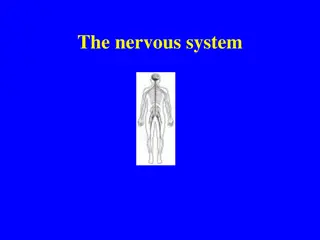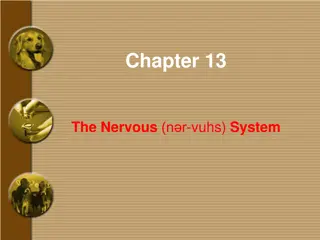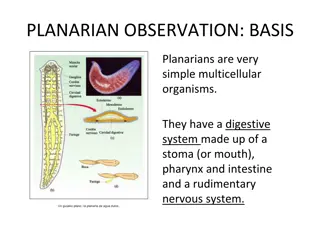Understanding the Central Nervous System and Brain
The central nervous system plays a crucial role in enabling organisms to respond to stimuli and adapt to changes in the environment. Comprising receptors, neurones, and effectors, this system facilitates the detection of stimuli, transmission of messages, and appropriate responses. Neurones, including sensory, relay, and motor neurones, work in coordination with effectors like muscles and glands to ensure effective responses. Additionally, synapses and reflex responses enable quick reactions to stimuli without conscious brain involvement.
Download Presentation

Please find below an Image/Link to download the presentation.
The content on the website is provided AS IS for your information and personal use only. It may not be sold, licensed, or shared on other websites without obtaining consent from the author. Download presentation by click this link. If you encounter any issues during the download, it is possible that the publisher has removed the file from their server.
E N D
Presentation Transcript
The Central Nervous System And the Brain !!
The Central Nervous System Organisms need to be able to respond to stimuli. There can be changes in the environment to which organisms may need to adapt to survive, for example if you were not able to feel pain you could be standing with your hand on a hot surface, being quite badly burnt and you would not know whether to respond to this or not. The nervous system gives you the ability to respond to your surroundings to remove or reduce injury or damage as a result of stimulus. The nervous system is made up of neurones (nerve cells) in the body which are interconnected to detect, and where necessary respond to stimulus. The nervous system is made up of several parts, receptors, neurones and effectors which detect stimuli (receptors), inform the brain of the detection (neurones) and receive messages containing instructions on how to respond (effectors).
The Central Nervous System The whole cycle, between detection of the stimulus and the response to it is handled by the cooperation between the receptors, effectors, neurones and the responders. There are many types of receptor, and depending on the stimulus the choice of effector and what it does will be determined. Messages passed between receptors and effectors are controlled by the neurones. The neurones communicate with the central nervous system through the spinal cord.
The Central Nervous System There are 3 neurones to be aware of: 1. Sensory Neurones which carry information as electrical impulses from the Receptors to the sense organs in the Central Nervous System. 2. Relay Neurones which carry electrical impulses from the Sensory Neurones to the Motor Neurones these are found in the Central Nervous System. 3. Motor Neurones which carry electrical impulses from the Central Nervous System to the Effectors. So what exactly are the Effectors?. These are either muscles or glands, and respond to the nervous impulses received from the Motor Neurones. In the case of muscles, they will usually contract and in the case of glands they will usually secrete chemical substances called hormones.
Hotspot 1 Q1. Which type of effector secretes hormones? A1. Consider the 2 types of effector, muscles and glands. Of course, only glands secrete hormones. Q2. Name the 3 types of neurones, briefly explain what each one does A2. Sensory Neurone - carries messages from the receptors to the CNS Relay Neurone - carries messages from the Sensory to the Motor Neurones Motor Neurone - carries messages from the CNS to the effectors NB: in all cases the messages are carried as electrical impulses
Synapses and Reflex Responses Some responses to stimulus happen automatically, they bypass the conscious part of the brain when a quick response is essential. It would not be a good thing if you had to pause for however short a time to think have I been burnt? . Your body just gets on with it and responds accordingly.
Synapses and Reflex Responses Perhaps the most obvious receptor is our sense of touch. When the receptors detect a form of stimulus, what happens next depends on the requisite response and is coordinated via the Central Nervous System. In vertebrate animals (animals with backbones) the Central Nervous System consists of the brain and spinal cord, additionally in mammals there is interconnection between sensory and motor neurones. All of these work together to detect stimulus and respond where needed.
Reflex Responses The CONSCIOUS part of the brain is bypassed in a reflex response.
The Brain A reflex arc is a neural pathway that controls a reflex. In vertebrates, most sensory neurons do not pass directly into the brain, but synapse in the spinal cord. This allows for faster reflex actions to occur by activating spinal motor neurons without the delay of routing signals through the brain.
The Brain We have seen that the brain is bypassed on some autonomic responses but that cannot be entirely accurate as the brain controls the whole body. We will now take a look at the various parts of the brain and examine the function of each.
CEREBRUM The Brain The cerebrum is the largest part of your brain and makes up about 80% of its mass. It is divided into two halves, or cerebral hemispheres. Each half takes information from, and control muscles of the opposite side of the body. Your Cerebrum is also the centre of your intelligence, memory, speech and consciousness. The outer layer, called the cerebral cortex, is folded and grooved, and is made up of billions of nerve cells, known as grey matter. Inside this is the thick white matter of the cerebrum, made up of connecting fibres.
CEREBELLUM The Brain The cerebellum, which means 'little brain', is found behind the brain stem. It has two folded and grooved halves which are responsible for co- ordinated body movements, posture and balance. The outer layer, or cortex, contains nerve cell, or grey matter, and under this run their fibres, in the white matter.
SPINAL CORD The Brain The spinal cord is a column of nerve tissue about 45 cm in length and as thick as a finger. It is protected by a column of bones called vertebrae that form the spine. The spinal cord and the brain make up the central nervous system, and together they control most of your body's activities. The 31 pairs of spinal nerves, which fan out from the spinal cord, form the peripheral nervous system. These provide the main links between your brain and the rest of your body.
MEDULLA OBLONGATA The Brain The medulla oblongata is the lowest part of the brain stem, next to the spinal cord. It is only 2.5 cm long. Nerve fibres cross over here, so that one side of your brain receives information from the opposite side of your body. The medulla oblongata is also the control centre for a number of vital body functions. These include: pacing of your heartbeat, controlling blood vessels & blood pressure, and setting the rate and depth of your breathing.
PITUITARY GLAND The Brain The pituitary gland is a small gland about the size of a pea, which is attached to the underside of the brain. It is made up of two halves, or lobes. The gland releases many important chemicals, called hormones into your blood stream. One hormone for example, affects the rate of your body's growth. many more control activities of other glands and, in turn, the release of many other essential hormones.
HYPOTHALAMUS The Brain The hypothalamus is a part of your brain, about the size of a cherry, that is located behind your eyes. It is an important regulator of many of your body's automatic functions, including those of the hormonal system. Although small, the hypothalamus regulates the heart and blood pressure (making it 'pound' after a fright). It also controls body temperature by making you shiver and sweat, hunger and fullness, thirst and water balance, emotions and sleep.
PONS The Brain This is where the spinal cord and the brain meet. Along with the medulla oblongata, it regulates breathing, making sure the tissues get enough oxygen.


